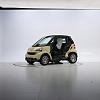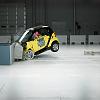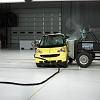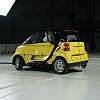Insurance Institute for Highway Safety for Smart 42
#1
Contributors
Thread Starter
Join Date: Sep 2006
Location: Hong Kong
Posts: 21,274
Likes: 0
Received 0 Likes
on
0 Posts
My Ride: Mini Cooper








First Institute crash tests of Smart car: diminutive two-seater earns top ratings for protecting people in front & side crashes
ARLINGTON, VA - The Smart car is getting a lot of attention for its small size and style, and now it's earning impressive crash test ratings. In recent Insurance Institute for Highway Safety tests, the 2008 Smart Fortwo, the smallest car for sale in the US market, earned the top rating of good for front and side crash protection. Its seat/head restraints earned the second highest rating of acceptable for protection against whiplash in rear impacts.
Smart Fortwo is classified a microcar, meaning it's smaller even than minicars. Weighing about 1,800 pounds, the Smart is more than 3 feet shorter and almost 700 pounds lighter than a Mini Cooper. It weighs about a third as much as one of the heaviest vehicles the Institute has tested, the BMW X5, a midsize SUV. As the price of fuel climbs and tougher federal fuel economy requirements kick in, auto companies are expected to introduce more small vehicles to the market. The Smart is the smallest car the Institute ever has tested.
"The big question from consumers is, 'How safe is it?'", says Institute president Adrian Lund. "All things being equal in safety, bigger and heavier is always better. But among the smallest cars, the engineers of the Smart did their homework and designed a high level of safety into a very small package."
The Institute's test results generally demonstrate how well vehicles stack up against others of similar size and weight. Frontal ratings can't be compared across weight classes, meaning a small car that earns a good rating isn't safer than a large car that's rated less than good.
"People base their buying decisions on a lot of factors," Lund says. "If you drive only in congested urban areas where speeds are low, a small car may be more practical than a big one. We conduct crash tests so people who want small cars can choose the ones that afford the best protection."
The Smart has a crashworthy design for its size and is equipped with the latest safety gear, which is especially important in a small car. This vehicle's standard equipment includes seat-mounted combination side airbags designed to protect both the heads and chests of the driver and passenger. Also standard is electronic stability control (ESC), called electronic stability program in the Smart. ESC helps drivers maintain control during emergency maneuvers or on slippery roads. It engages automatically when it senses vehicle instability, and Institute research has found that ESC lowers the risk of fatal single-vehicle crashes by about half.
Restraints do more of the work in frontal crashes: The Smart mostly lacks a front-end crush zone, which is a key component in reducing injury risk in serious frontal crashes. Typically, front-end structures are designed to crush and absorb crash energy, allowing occupant compartments to slow more gradually, ideally with little or no intrusion into drivers' survival space. Then a vehicle's safety belts and airbags slow occupants further and are designed to spread crash forces more evenly across people's bodies. The longer the front-end crush structure of a vehicle, the more gently occupants are slowed and thus protected from injury.
To compensate for the lack of front-end crush space, the Smart's restraint system does more of the work of absorbing energy as occupants "ride down" a crash. "We recorded a high head acceleration when the driver dummy's head hit the steering wheel through the frontal airbag," Lund explains. This indicates the test dummy used up all of the available ride down room in the Smart's interior.
A stiff side structure and standard side airbags contributed to the Smart's good rating in the side test, which replicates a crash with a pickup truck or SUV. Injury forces recorded on the driver dummy's head, neck, torso, pelvis, and left leg all were low. However, the driver door unlatched during the crash. This confirms a finding of the National Highway Traffic Safety Administration's side test of a Smart released last month. The Institute downgraded the Smart's structural rating from good to acceptable, but the opening didn't appear to affect dummy movement during the test, and injury measures on the driver dummy were low. Still, doors shouldn't unlatch because in some crashes it could allow partial or complete occupant ejection, especially if an occupant is unbelted.
Small car safety: While small cars are safer now than before, so are large cars. In every category of passenger vehicle (car, SUV, or pickup truck), the risk of death is higher in crashes of smaller, lighter models. For vehicles 1-3 years old during 2006, minicars experienced 106 driver deaths per million registered vehicles compared with 69 driver deaths in large cars.
People often choose very light cars for fuel economy, but "you don't have to buy the smallest, lightest car to get one that's easy on fuel consumption," Lund points out. "The Toyota Prius, for example, earns good front and side crash test ratings. It gets better fuel economy than a microcar, but it's bigger and weighs more so we would expect it would be more protective in serious crashes."
How the Smart was evaluated: The Institute's frontal crashworthiness evaluation is based on results of a 40 mph frontal offset crash test. A vehicle's overall evaluation is based on measurements of intrusion into the occupant compartment, injury measures recorded on a Hybrid III dummy in the driver seat, and analysis of slow-motion film to assess how well the restraint system controlled dummy movement during the test.
The side evaluation is based on performance in a crash test in which the side of a vehicle is struck by a barrier moving at 31 mph. The barrier represents the front end of a pickup or SUV. Ratings reflect injury measures recorded on an instrumented SID-IIs dummy in the driver seat, assessment of head protection countermeasures, and the vehicle's structural performance during the impact.
Rear crash protection is rated according to a two-step procedure. Starting points are measurements of head restraint geometry - the height of a restraint and its horizontal distance behind the back of the head of an average-size man. Seats with good or acceptable restraint geometry are tested dynamically using a dummy that measures forces on the neck. This test simulates a collision in which a stationary vehicle is struck in the rear at 20 mph. Seats without good or acceptable geometry are rated poor overall because they can't be positioned to protect many people.
Tags: breaking, crash results, crash tests, CrashResults, CrashTests, fortwo, smart, smart fortwo crash results, smart fortwo crash tests, SmartFortwoCrashResults, SmartFortwoCrashTests
#2
Contributors
Join Date: Sep 2007
Location: United States - Rhode Island
Posts: 334
Likes: 0
Received 0 Likes
on
0 Posts
My Ride: 2008 535xi
Monaco Blue
Dark Burl Walnut
Black Leather
Comfort Package
Sports Package
Cold Weather Package
Nav
Logic 7
18" Sport Wheels
Xenon Interior and License Plate Light Upgrade
How does it do in the tests where a Hummer runs over it?
#3
Senior Members
Join Date: Dec 2005
Location: Seattle, WA Metro Area
Posts: 1,794
Likes: 0
Received 0 Likes
on
0 Posts
Originally Posted by kearflex' post='581152' date='May 15 2008, 09:41 AM
How does it do in the tests where a Hummer runs over it?
Personally, I take what the IIHS publishes with a HUGE grain of salt. They're a little biased and have put out some pretty weak arguments advocating lower speed limits for me to take them seriously. But they sure have cool looking crash photos and videos.
#4
Contributors
Join Date: Jan 2005
Location: San Jose, California, USA
Posts: 4,119
Likes: 0
Received 0 Likes
on
0 Posts
My Ride: 2008 Porsche 911 Carrera S Convertible. Midnight Blue, 6 Speed.Retired - 2007 997 Carrera S, Midnight Blue, Grey leather, premium audioRetired - 2007 550i, Monaco Blue over Beige, Navigation, Logic 7, Cold Weather Pack, Comfort Access, Sport Package
Model Year: 2008
Originally Posted by kearflex' post='581152' date='May 15 2008, 06:41 AM
How does it do in the tests where a Hummer runs over it?
Thread
Thread Starter
Forum
Replies
Last Post
bestofthebest
Complete Car Sales
4
03-28-2016 02:47 PM
jluzbet
Private Member Classifieds
2
11-07-2015 01:25 PM


